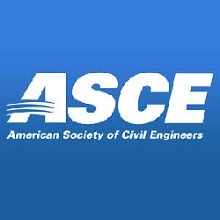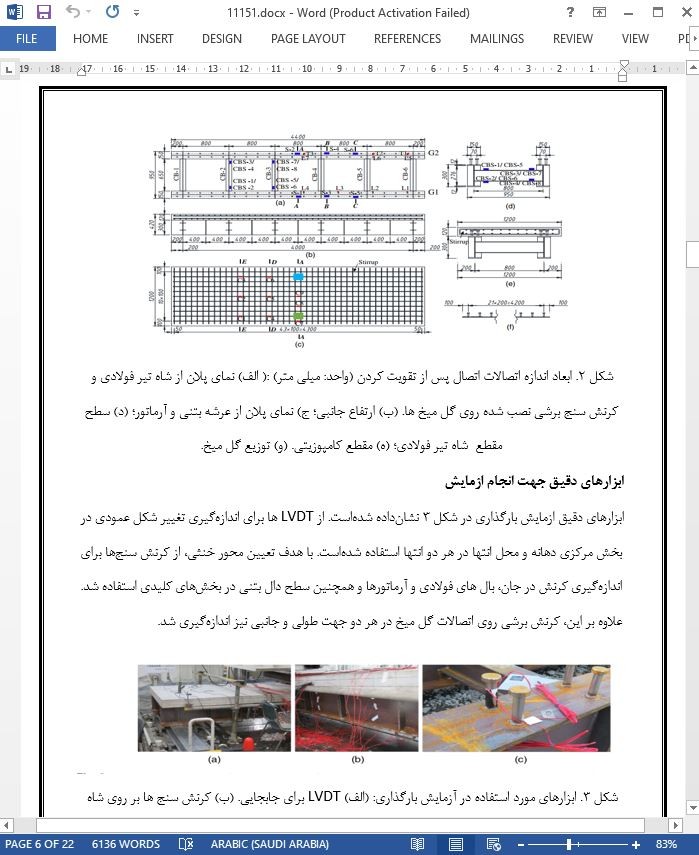
مطالعه آزمایشی بر روی پل های کامپوزیتی بتنی- فولادی دارای دو شاه تیر I شکل
چکیده
تعداد زیادی از پل های کامپوزیتی بتنی- فولادی دارای دو شاه تیر I شکل هم در اروپا و هم در ژاپن ساخته شدهاند، اما عدم فراوانی انها همواره نگرانی در ایالاتمتحده و بسیاری از کشورهای دیگر بودهاست. علاوه بر این، مطالعات ازمایشی بسیار کمی بر روی عملکرد مکانیکی چنین پلهایی، به ویژه برای پلهای دارای دو شاه تیر I شکل سالم انجام شدهاست. در این زمینه، یک نمونه از پل های کامپوزیتی بتنی- فولادی دارای دو شاه تیر I شکل مطابق با مشخصات طراحی پل بزرگراه فعلی در ژاپن طراحی شدهاست. آزمایشهای بارگذاری استاتیکی انجام شد و دو شرایط بارگذاری شامل بارگذاری متقارن و بارگذاری نامتقارن اعمال شد. رابطه بار بر حسب خیز و توسعه کرنش بر روی تیرهای اصلی فولادی و دال بتنی در بخشهای(مقاطع) کلیدی اندازهگیری شد. کرنشهای خمشی بر روی تیر جانبی نیز در این مقاله برای تایید انتقال بار بین دو شاه تیر اصلی اندازهگیری و گزارش شدهاست. به علاوه، کرنش برشی اتصالات برشی(گل میخ ، در این مطالعه) نیز برای بررسی انتقال نیروی برشی بر روی سطح مشترک بتنی- فولادی اندازهگیری شد. مقادیر نظری نیز برای مقایسه با نتایج ازمایشی از نمونه های شاه تیر تحت شرایط بارگذاری متقارن ارایه شدند. نتایج ازمایشی نشان میدهد که تحلیل نظری میتواند رفتار دو شاه تیر I شکل را به خوبی در مرحله الاستیک با در نظر گرفتن عرض موثر دال پیشبینی کند. عملکرد هر مولفه ی سازهای و مسیر انتقال بار در چنین پلهایی نیز مورد بحث قرار گرفت.
معرفی
پلهای دارای چند شاه تیر، همانطور که در شکل ۱(a) نشانداده شدهاست، یکی از متداولترین انواع پل های کامپوزیتی با دهانه متوسط هستند، که میتواند برای یک دهانه واحد یا برای چند دهانه پیوسته مورد استفاده قرار گیرد. به ویژه در جایی که عمق ساختوساز محدود است، موثر است. در پلهای دارای چند شاه تیر، تعدادی از تیر ورق های طولی با اندازه مشابه در فواصل یکسان در عرض پل قرار داده میشوند. دهانه های دال عرشه به طور عرضی بین شاه تیرهای طولی و کنسول های عرضی در خارج از شاه تیرهای خارجی قرار گرفتهاست (صراف و همکاران ۲۰۱۳). شاه تیرها در کنار یکدیگر و در برخی موقعیتهای میانی محکم شدهاند. عمل کامپوزیت بین عرشه ی دال بتن مسلح و شاه تیرهای طولی با استفاده از اتصالات برشی جوش دادهشده به بال های بالایی شاه تیرهای فولادی به دست میآید. از آنجا که پل های دارای دو شاه تیر I شکل براساس ویژگیهای آشتو(AASHTO) (۲۰۱۲)به عنوان سازههای غیر اضافی(نامعین) طبقهبندی میشود،
نکات پایانی(نتایج)
آزمایشهای بارگذاری استاتیکی بر روی مدل پل دارای دو شاه تیر کامپوزیتی فولادی – بتنی سالم انجام شد. آزمایشهای بارگذاری استاتیکی تفصیلی شامل پاسخ بار - جابجایی و روابط بار - کرنش بر روی شاه تیر فولادی، دال بتنی، اتصالات برشی گل میخ و تیرهای عرضی در این مقاله گزارش و به دقت مورد بررسی قرار گرفتهاست. دو شرایط بارگذاری شامل بارگذاری متقارن و بارگذاری نامتقارن در تست بارگذاری اعمال شدند. با توجه به نتایج ارایهشده در اینجا، نتایج و توصیههای زیر ارایه میشوند:
• نتایج تئوری مطابق با تئوری طراحی الاستیک رایج تعیین میشوند که شامل تغییرمکان ها در مقاطع مختلف و کرنش ها در اعضای مختلف است و با نتایج تست به خوبی مطابقت دارد. بنابراین، پلهای دارای دو شاه تیراصلی I شکل را میتوان با توجه به روش طراحی پل فعلی به خوبی طراحی کرد.
Abstract
A large number of steel–concrete composite twin I-girder bridges have been built in both Europe and Japan, but the lack of redundancy has always been a concern in the US and many other countries. In addition, very few experimental studies have been performed on mechanical performance of such bridges, particularly for the intact twin I-girder bridges. On this background, a steel–concrete composite twin I-girder bridge specimen was designed according to the current highway bridge design specification in Japan. Static loading tests were performed, and two loading conditions including both symmetric loading and asymmetric loading were applied. The load versus deflection relationship and strain development on the steel main girders and concrete slab at key sections were measured. The flexural strains on the lateral beam were also measured and reported in this paper to confirm the load transfer between two main girders. In addition, the shear strain of shear connectors (stud, in this study) was also measured to investigate the shear force transmission on the steel–concrete interface. The theoretical values were also provided to compare with the test results from the twin girder specimen under symmetric loading condition. The experimental results indicate that the theoretical analysis can predict the behavior of the twin girders very well in the elastic stage by considering the effective width of the slab. The performances of each structural component and load transfer path in such bridges were also discussed.
Introduction
Fig. 1(a), Multigirder bridges, as shown in are one of the most common types of medium-span composite bridge, which can be used for a single span or for continuous multiple spans, and it is particularly effective where construction depth is limited. In multigirder bridges, a number of similarly sized longitudinal plate girders are arranged at uniform spacing across the width of the bridge. The deck slab spans transversely between the longitudinal girders and cantilevers transversely outside the outer girders (Sarraf et al. 2013). The girders are braced together at supports and at some intermediate positions. Composite action between the reinforced concrete deck slab and the longitudinal girders is achieved by means of shear connectors welded on the top flanges of the steel girders. Because twin girder bridges are classified as nonredundant structures according AASHTO (2012) specifications, their construction was rather limited in the US and many other countries. Recently, however, the two-girder steel–concrete composite bridges have been widely used in practice in several other countries, like Japan.
Concluding
Remarks Static loading tests were performed on an intact steel–concrete composite twin girder bridge model. Detailed static loading tests involving load–displacement response and load–strain relationships on the steel girder, concrete slab, stud shear connectors, and cross beams were reported and examined carefully in this paper. Two loading conditions including both symmetrical loading and asymmetrical loading were applied in the loading test. From the results presented herein, the following conclusions and recommendations are made:
• The theoretical results determined according to the current elastic design theory, including both displacements on different sections and strains on different members, agree well with the test results. Therefore, twin I-girder bridges can be designed appropriately according to the current bridge design method.
چکیده
معرفی
برنامه آزمایشی
نمونه آزمایشی
ابزارهای دقیق جهت انجام ازمایش
روند اماده سازی ازمایش و بارگذاری
ویژگیهای مصالح
نتایج تست و بحث
پاسخ بار- تغییرمکان
کرنش در شاه تیرهای اصلی فولادی
کرنش در دال بتنی
کرنش در تیرهای عرضی
نتایج کرنش در اتصال دهنده های برشی
نکات پایانی(نتایج)
Abstract
Introduction
Experimental Program
Test Specimen
Instrumentation
Test Setup and Loading Procedure
Material Properties
Test Results and Discussion
Load–Deflection Response
Strain on the Steel Main Girders
Strain on Concrete Slab
Strain on Cross Beams
Strain Results on Shear Connectors
Concluding Remarks
- ترجمه فارسی مقاله با فرمت ورد (word) با قابلیت ویرایش، بدون آرم سایت ای ترجمه
- ترجمه فارسی مقاله با فرمت pdf، بدون آرم سایت ای ترجمه



